牛津译林版八年级上Unit 2 School life More Practice Counting Before Numbers 课件(共19张PPT)
文档属性
| 名称 | 牛津译林版八年级上Unit 2 School life More Practice Counting Before Numbers 课件(共19张PPT) | 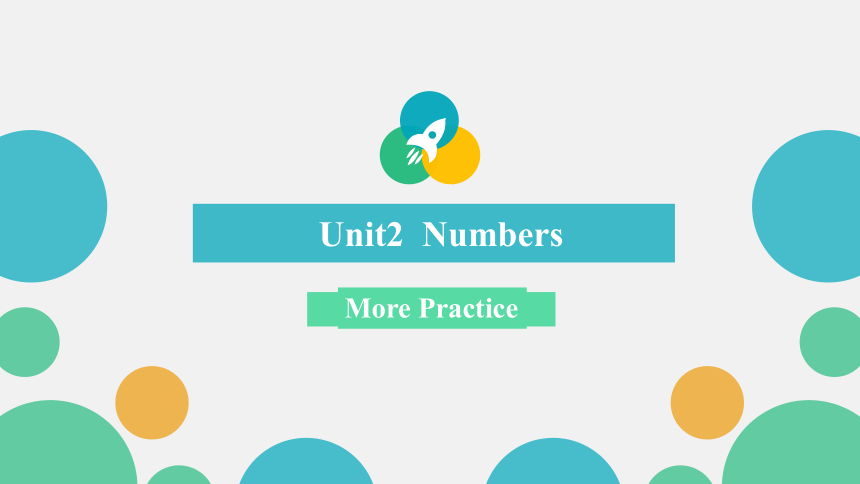 | |
| 格式 | pptx | ||
| 文件大小 | 1.5MB | ||
| 资源类型 | 教案 | ||
| 版本资源 | 牛津译林版 | ||
| 科目 | 英语 | ||
| 更新时间 | 2022-08-14 17:06:16 | ||
图片预览

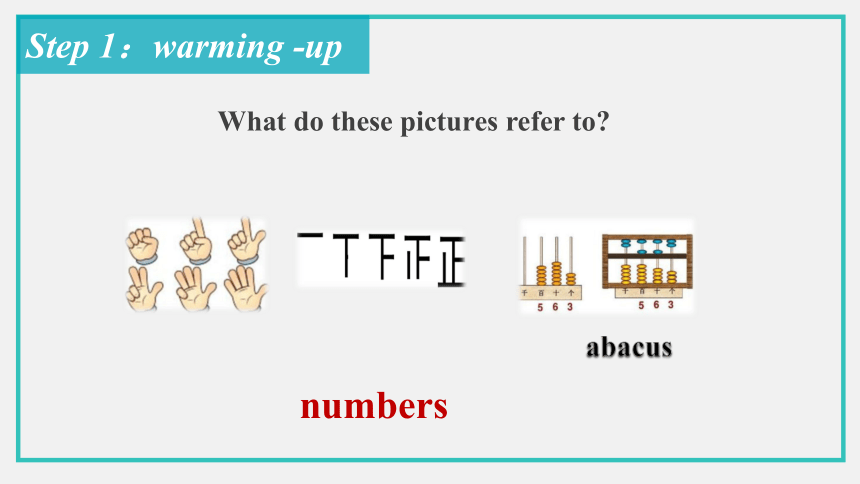
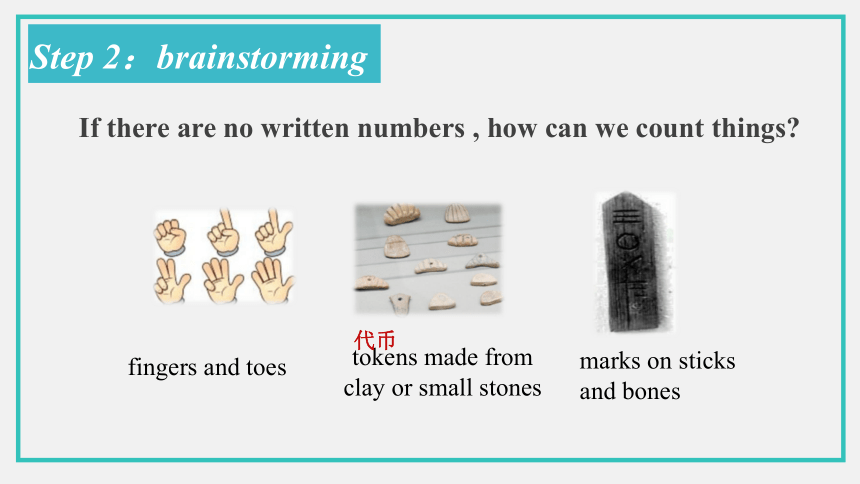
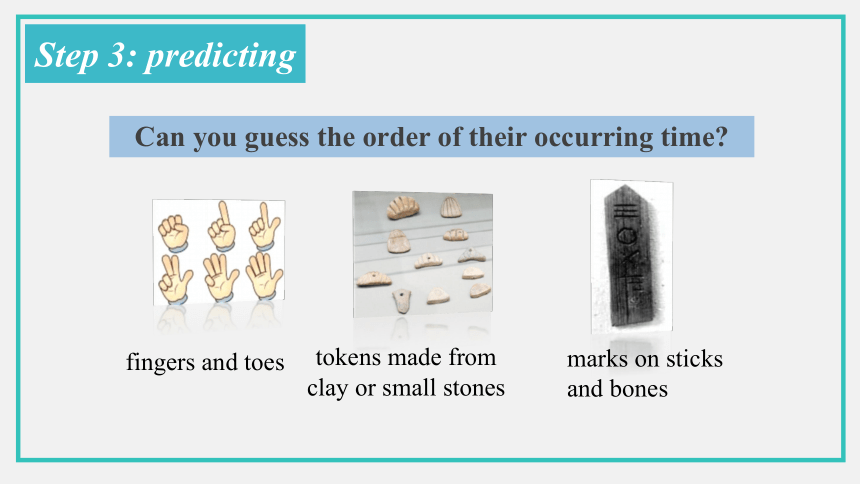
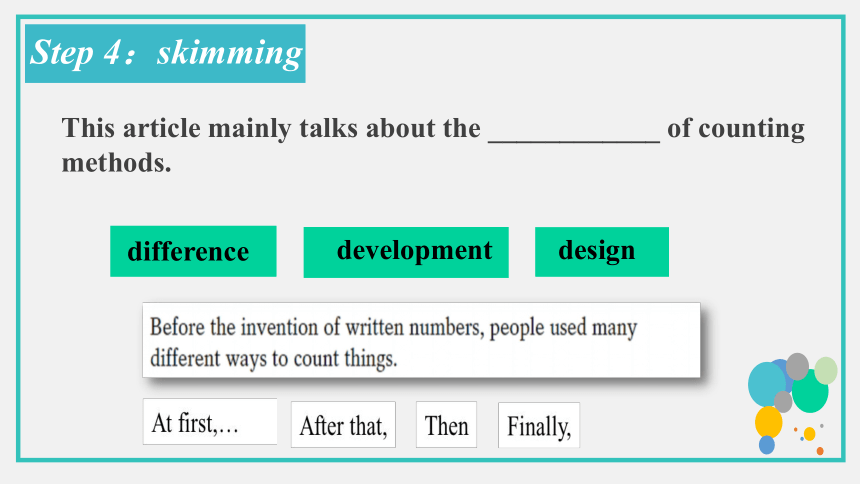
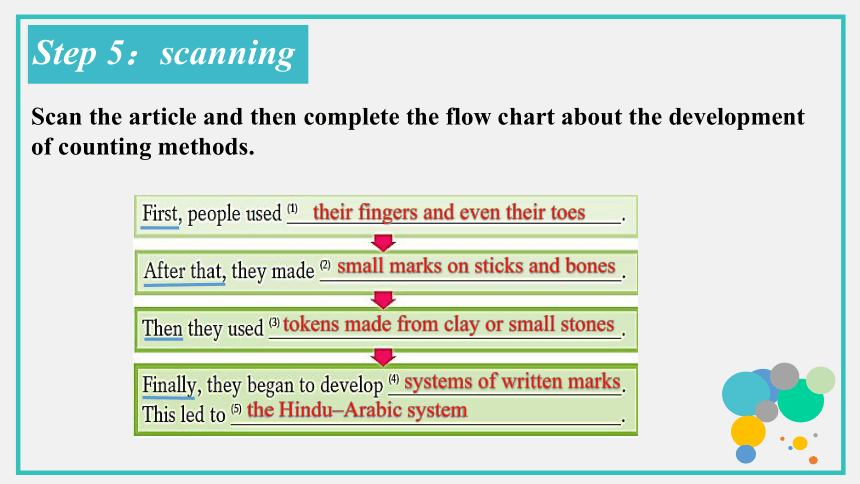
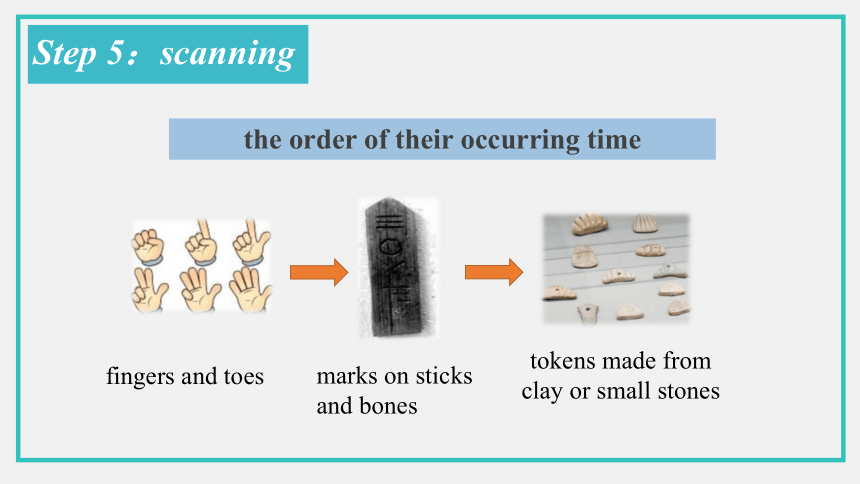
文档简介
(共19张PPT)
Unit2 Numbers
More Practice
What do these pictures refer to
Step 1:warming -up
numbers
abacus
If there are no written numbers , how can we count things
tokens made from clay or small stones
Step 2:brainstorming
fingers and toes
代币
marks on sticks and bones
Can you guess the order of their occurring time
tokens made from clay or small stones
Step 3: predicting
fingers and toes
marks on sticks and bones
This article mainly talks about the ____________ of counting methods.
difference
development
design
Step 4:skimming
Scan the article and then complete the flow chart about the development of counting methods.
their fingers and even their toes
small marks on sticks and bones
tokens made from clay or small stones
systems of written marks
the Hindu–Arabic system
Step 5:scanning
the order of their occurring time
tokens made from clay or small stones
fingers and toes
marks on sticks and bones
Step 5:scanning
Step 6:Intensive reading
could count
At first
small numbers
used
fingers and toes
At first, people used their fingers, and even their toes. However they could only count small numbers in this way.
Step 6:Intensive reading
After that, they began to make small marks on sticks and bones. This helped them count bigger numbers. They used them to count things like the days of the month, the amount of food and the number of animals they had.
After that
began to
make
marks on sticks and bones
helped…
count
bigger numbers
like
the days of the month
the amount of food
the number of animals
Step 6:Intensive reading
Then people began to use tokens made from clay or small stones. This helped them count even bigger numbers. They often put the tokens on pieces of string so that they could carry them around easily. This developed into tools like the abacus.
Then
began to
use
to count
even bigger numbers
put…on…
developed into
tokens made from clay or small stones
tools
Step 6:Intensive reading
Finally, people began to develop systems of written marks to show different numbers, and this led to the Hindu-Arabic system (0-9). We are still using this system today.
Finally
began to
develop
to show
different numbers
led to
systems of written marks
Hindu-Arabic system
Step 6:Intensive reading
However, they could only count small numbers in this way.
This helped them count bigger numbers.
This helped them count even bigger numbers.
Using their fingers and even their toes
Making small marks on sticks and bones
Using tokens made from clay or small stones
What does this refer to
Step 6:Intensive reading
This developed into tools like the abacus.
… and this led to the Hindu-Arabic system (0~9).
We are still using this system today.
Putting the tokens on pieces of string
Developing systems of written marks
The Hindu-Arabic system
What does this refer to
This often refers to something mentioned before.
Things people used What to count Examples
fingers and toes
small numbers
(small) marks on sticks and bones
bigger numbers
tokens made from clay or small stones
even bigger numbers
systems of written marks
the days of the month
the amount of food
the number of animals
the Hindu-Arabic system (0-9)
the abacus
development
more and more advanced
different
numbers
Step 7:Retell
At first,
Then,
After that,
Finally,
Step 8:Further-thinking
different numbers
for example
Step 9:Creative story-making
…
Choose some of the pictures below and then try to make a short story.
Step 9:Creative story-making
a 10-year-old boy
135 cm tall
On October 21, 2019
his ninth birthday
unforgettable
got up at 7:00 in the morning
cost 49.99 yuan
fifty percent off
watched the football match
France won by 3-2
saw strong smoke coming out
called 119
the fire was put out
At first,
After that,
Then,
Finally,
Homework
Think of more occasions (场合) where we use numbers and then try to make a short story with them.
Review the article we learned today and fill in the blanks.
_____, people used their _____ and even their _____. However they could only count _____ in this way.
_____, they began to make _____.This helped them count _____ . They used them to count things like the days of the month, the amount of food and the number of animals they had.
_____ people began to use _____. This helped them count _____ . They often put the tokens on pieces of string so that they could carry them around easily. This developed into tools like the _____.
_____, people began to develop _____ to show _____, and this led to the Hindu-Arabic system (0-9). We are still using this system today.
Thank you for listening
Unit2 Numbers
More Practice
What do these pictures refer to
Step 1:warming -up
numbers
abacus
If there are no written numbers , how can we count things
tokens made from clay or small stones
Step 2:brainstorming
fingers and toes
代币
marks on sticks and bones
Can you guess the order of their occurring time
tokens made from clay or small stones
Step 3: predicting
fingers and toes
marks on sticks and bones
This article mainly talks about the ____________ of counting methods.
difference
development
design
Step 4:skimming
Scan the article and then complete the flow chart about the development of counting methods.
their fingers and even their toes
small marks on sticks and bones
tokens made from clay or small stones
systems of written marks
the Hindu–Arabic system
Step 5:scanning
the order of their occurring time
tokens made from clay or small stones
fingers and toes
marks on sticks and bones
Step 5:scanning
Step 6:Intensive reading
could count
At first
small numbers
used
fingers and toes
At first, people used their fingers, and even their toes. However they could only count small numbers in this way.
Step 6:Intensive reading
After that, they began to make small marks on sticks and bones. This helped them count bigger numbers. They used them to count things like the days of the month, the amount of food and the number of animals they had.
After that
began to
make
marks on sticks and bones
helped…
count
bigger numbers
like
the days of the month
the amount of food
the number of animals
Step 6:Intensive reading
Then people began to use tokens made from clay or small stones. This helped them count even bigger numbers. They often put the tokens on pieces of string so that they could carry them around easily. This developed into tools like the abacus.
Then
began to
use
to count
even bigger numbers
put…on…
developed into
tokens made from clay or small stones
tools
Step 6:Intensive reading
Finally, people began to develop systems of written marks to show different numbers, and this led to the Hindu-Arabic system (0-9). We are still using this system today.
Finally
began to
develop
to show
different numbers
led to
systems of written marks
Hindu-Arabic system
Step 6:Intensive reading
However, they could only count small numbers in this way.
This helped them count bigger numbers.
This helped them count even bigger numbers.
Using their fingers and even their toes
Making small marks on sticks and bones
Using tokens made from clay or small stones
What does this refer to
Step 6:Intensive reading
This developed into tools like the abacus.
… and this led to the Hindu-Arabic system (0~9).
We are still using this system today.
Putting the tokens on pieces of string
Developing systems of written marks
The Hindu-Arabic system
What does this refer to
This often refers to something mentioned before.
Things people used What to count Examples
fingers and toes
small numbers
(small) marks on sticks and bones
bigger numbers
tokens made from clay or small stones
even bigger numbers
systems of written marks
the days of the month
the amount of food
the number of animals
the Hindu-Arabic system (0-9)
the abacus
development
more and more advanced
different
numbers
Step 7:Retell
At first,
Then,
After that,
Finally,
Step 8:Further-thinking
different numbers
for example
Step 9:Creative story-making
…
Choose some of the pictures below and then try to make a short story.
Step 9:Creative story-making
a 10-year-old boy
135 cm tall
On October 21, 2019
his ninth birthday
unforgettable
got up at 7:00 in the morning
cost 49.99 yuan
fifty percent off
watched the football match
France won by 3-2
saw strong smoke coming out
called 119
the fire was put out
At first,
After that,
Then,
Finally,
Homework
Think of more occasions (场合) where we use numbers and then try to make a short story with them.
Review the article we learned today and fill in the blanks.
_____, people used their _____ and even their _____. However they could only count _____ in this way.
_____, they began to make _____.This helped them count _____ . They used them to count things like the days of the month, the amount of food and the number of animals they had.
_____ people began to use _____. This helped them count _____ . They often put the tokens on pieces of string so that they could carry them around easily. This developed into tools like the _____.
_____, people began to develop _____ to show _____, and this led to the Hindu-Arabic system (0-9). We are still using this system today.
Thank you for listening
